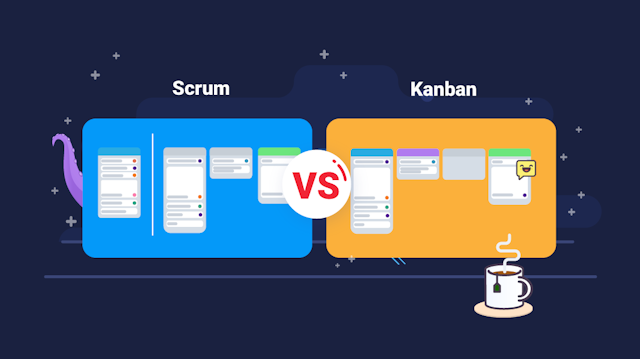OKRs have helped lead us to 10x growth, many times over. They’ve helped make our crazily bold mission of 'organizing the world’s information' perhaps even achievable.Larry Page, former CEO of Alphabet, and co-founder of Google
OKRs (or Objective Key Results) is a goal-setting framework used by leading tech companies (like Google, Intel, Amazon) to align their efforts towards an Objective (big goal) by achieving a predefined set of metrics called Key Results.
KPIs (or Key Performance Indicators) are performance indicators (metrics) that are measured in a pre-defined way and reviewed over a fixed period (frequency) to monitor (measure) the success of an activity, project, employee, team or an organization.
Short answer. OKRs and KPIs are different, but they can play together. OKRs define a goal with a set of metrics, while KPIs are metrics that can be part of an OKR’s Key Results or be standalone performance indicators.
Don’t worry if you don’t quite get it! In this article, we’ll first explain to you what exactly OKRs and KPIs are, then we’ll give you real-life examples, and in the end, we’ll compare them so you can have a better understanding and find answers to your questions.
Here’s what you’ll learn:
- What is an OKR?
- How to write OKRs?
- OKRs Examples
- What is a KPI?
- How to set KPIs?
- KPI Examples
- OKRs vs. KPIs: Similarities & Differences
- How OKRs and KPIs can play together?
Our goal is this page to be the last page you’ll ever have to read to fully-understand what OKRs and KPIs are and to be able to answer the question, "What are the differences between OKRs and KPIs?" without even thinking.
So let’s begin!
1. What is an OKR?
OKR Definition
OKR (Objective & Key Results) is a goal-setting framework helping companies and organizations to align their teams toward achieving an Objective (goal) defined by a set of metrics called Key Results.The history of OKRs can be traced back to around 1968 when Andry Groove ("the father of OKRS") co-founded Intel and has upgraded the MBO (Management by Objectives) model into the OKRs we know today.
The OKR model gained a lot of popularity after Larry Page (the co-founder of Google) adopted OKRs to make Google’s bold mission of "organizing the world’s information" achievable. Since that, OKRs have been used at other popular tech start-ups like LinkedIn, Twitter, and Uber.
The Objective & Key Results (OKR) framework consists of two parts - Objective and Key Results.
Objective
Objectives define where you want to go. They should be ambitious, specific, and time-bound goals that inspire employees to move the company forward. Objectives are usually defined quarterly or annually.
Objective example: "Achieve record signups in the 1st quarter of 2022."
Key Results
Key Results define how do you plan to go there. They are the metrics required for achieving your Objective (goal). The Key Results must be specific, measurable (quantifiable), achievable, progress you towards your objective, and be difficult but not impossible.
Key Results example:
- KR1: "Generate an extra 2,000 clicks per month on Ora’s blog posts."
- KR2: "Increase landing page conversion from 22% to 30%."
- KR3: "Get an extra 500 organic website clicks per month on the landing page for ‘project management’ keywords."
2. How to write OKRs?

Writing OKRs have helped dozens of billion-dollar organizations like Google, Intel, Amazon to align, motivate, and empower their teams towards achieving their goals.
OKRs are also applicable in small teams and startups, too. Considering that, Google and Amazon both started in a garage with a team of few people.
To write a good OKR, you should begin by setting the Objective (goal/vision that you want to achieve) first. For example, let’s take a company that wants to "create a real-life Star Wars lightsaber for everyone".

Writing an Objective
When setting OKRs, the Objective should always be inspired by the company’s mission/vision and be defined by the highest management. It also should be bold, inspiring for everyone, and time-bound.
What Objectives should NOT be:
- Generic (objectives should be specific)
- Easy (objectives should be ambitious)
- Boring (objectives should be inspirational)
An OKR Objective should answer YES to the following questions:
- Is it inspiring?
- Does it move the company forward?
- Does it help to achieve the company’s vision?
- Is it time-bound?
- Annual or quarterly?
Objectives are meant to drive companies and individuals towards their goals while keeping them motivated and focused even during hard times. The right objective will serve as the North Star that'll guide your venture to success.
A good Objective for the Lightsaber OKR can be:
O: "Create the first real-life affordable Star Wars lightsaber in 2022."
Examples of bad Objectives:
- "Make more revenue this year."
- "Grow the company."
- "Release new product."
Once we have a good Objective, the next step is defining the right metrics (Key Results) for achieving it.
Defining Key Results
Key Results are a set of metrics that measure the progress towards your Objective. They must be thought carefully and planned in a way that if all of them are met, your Objective (goal) will get accomplished.
Note: Key results are not tasks.
Key Results should not be tasks. They are meant to be measurable metrics (similar to KPIs) that support the OKR objective, not a todo list items.An OKR Key Result should answer the following questions positively:
- Is it specific?
- Important for achieving the Objective?
- Is it measurable (defined by numbers)?
- Is it hard but achievable?
The purpose of the key results is to serve as milestones to the Objective. Set correctly, they should define a rationale and measurable plan (which progress can be tracked) towards achieving the objective.
Good Key results for the Lightsaber OKR can be:
- KR1: "Gather a team of the top 30 leading physicists in the world."
- KR2: "Create a 3,000° plasma blade prototype that can cut through metal."
- KR3: "Achieve a product cost of $79."
- KR4: "Get 5,000 pre-orders from the landing page."
- KR5: "Legalize the product in 35 countries."
Writing OKRs
The last step to setting great OKRs that’ll transform your company is to write them down. A good way to do so is using the Doerr’s Formula. (John Doerr is a venture capitalist who invested in Google, and introduced them to the OKRs model)
Doerr’s OKR Formula:
I will _______ as measured by_____________________.
Or to bring more clarity:
I will (Objective) as measured by (Key Result metrics).
Star Wars Lightsaber OKR using the Doerr’s formula:
"I will create the first real-life affordable Star Wars lightsaber in 2022 (O) as measured by gathering a team of the top 30 leading physicists in the world (KR1), creating a 3,000° plasma blade prototype that can cut through metal (KR2), achieving a product cost of $79 (KR3), and getting 5,000 pre-orders from the landing page. (KR4)"If done correctly, your OKRs should roll off the tongue and excite your listeners!
To set OKRs in a multi-level organization, start by setting an OKR on the C-level and then spread the OKRs across the whole organization.
Star Wars Lightsaber OKR Objectives in a multi-level organization:
- HR team: "Recruit the top 30 leading physicists in the world." (O1)
- Science team: "Create a 3,000° plasma blade that can cut through metal." (O2)
- Business team: "Achieve a product cost of $79." (03)
- Marketing team: "Get 5,000 pre-orders from the landing page." (04)

3. OKR Examples
In this section, we'll give you 5 OKR examples that you can use as inspiration for setting your own ones. We've also included two public OKRs set by real businesses in 2022.
OKR Example 1: Software Team
Objective: "Build the cleanest SOLID codebase in the world by Q2."
- KR1: "Refactor 135 classes using the latest best practices in 2022."
- KR2: "Fix 99% of the minor warnings (including code formatting)."
- KR3: "Cover 80% of the executable code with unit and Integration tests."
OKR Example 2: Marketing & Sales Team
Objective: "Accomplish record revenue growth in 2022."
- KR1: "Increase (quality) leads generated per month by 25%."
- KR2: "Achieve closing ratio on sales opportunities of 45%."
- KR3: "Generate an extra of 10,000 organic website visitors per month."
OKR Example 3: Support Team
Objective: "Become the highest rated customer support team in Capterra before Q3."
- KR1: "Decrease avg. response time from 4min13s to 2min35s even on the weekends."
- KR2: "Achieve customer support satisfaction score of 4.9/5 stars."
OKR Example 4 (Real-life): Gitlab's Public OKRs (2022)
CEO Objective: "Popular next-generation product."
- KR1: "SMAU is being measured and reported in 100% of Sales and Product Key Meetings."
- KR2: "SPU increases by 0.5 stages from EOQ4 to EOQ1."
- KR3: "MAU (Monthly Active Users) increases 5% from EOQ4 to EOQ1."
OKR Example 5 (Real-life): Ora's Public OKRs
CEO Objective: "Become the most intuitive all-in-one project management solution for software and marketing teams in Q4, 2022."
- KR1: "Interview 50 of our top target customers and collect their feedback."
- KR2: "Run 1,000 usability tests after making any major UX improvements."
- KR3: "Develop 75% of the planned features in Ora’s Public Roadmap."
- KR4: "Increase CAS (Customer Activation Score) to 89%."
4. What is a KPI?
KPI definition
By definition, KPI (Key Performance Indicator) is a quantifiable measure used to evaluate the success of an organization, product, project, employee, activity, or initiative over time.KPI is an important number metric that measures (strictly) and monitors the performance of something (it can be anything; e.g., activity, team, employee product, project, business) over time.
Good example that everyone who's been in sales is familiar with is the "Target", or more formal "Closed-won deals target per employee per month."
Explained simply: KPI monitors the health (the performance) of something by being measured and reviewed over fixed frequency (periods of time) and being compared to a predefined target.

KPI Components
KPIs have four components - a measure, a target, a data source, and a frequency.
- Measure - defines what you want to measure
- Target - the value of the Measure that you want to achieve
- Data Source - from where would you be gathering the data for the KPI
- Frequency - how often will you monitor the KPI
KPIs serve as the core pillars of monitoring the success of your business, initiatives, or employees. Now we’ll go through each of the components of a KPI and explain their meaning.
Measure
The Measure represents what you want to monitor and defines how it would be measured. Remember this for now, and we’ll get in more detail in 5. How to set great KPIs.
Target
The KPI Target is the desired value that you want your Measure to be. For example, 10k monthly traffic, 30% conversion rate, 5% revenue increase, and so on.
Data Source
The Data Source defines how you’re going to obtain the data for the KPI. For example, common data sources can be Google Analytics, CRM, Database, Project Management Software, and so on.
Frequency
KPI’s Frequency defines how often you're going to pull the data and review your KPI. It can be daily, weekly, monthly, quarterly, or yearly depending on the measured metric and business specifics.
In the section, we’ll show you how to set great KPIs by choosing the right Metric to monitor from the right Data Sources with the right Frequency towards achieving the right Target.
5. How to set great KPIs?
Now that you know what KPIs are, it’s time to set ones for your business.
Start by choosing what you would like to know about and monitor in your business. If you have trouble coming up with ideas, imagine that Siri or your Google Assistant got all the data about your business. What would you ask?
For example, I’d like to know:
- Siri, how much revenue would we make this month?
- Are our sales going up or down?
- Is our website attracting more visitors compared to the last 3 months?
- What’s the average amount of money a client is spending with us?
So knowing what metrics we’d like to track, let’s set KPIs for them!
For the sake of simplicity, we’ll be setting an e-Commerce Website KPIs as an example.

Setting the right Measure
The first step in setting a KPI is defining how you would measure it. When choosing the right metrics (measures), it’s important for them to be quantitative or said simply - defined by numbers.
For the e-Commerce website example, you might want to measure:
- # of monthly website visitors
- % decrease of bounce rate (visitors who left the website w/o looking)
- % of visitors who buy an item (conversion)
- $ monthly revenue
- CLV (Customer Lifetime Value) or avg. of money ($$$) earned from each acquired customer
KPIs ≠ Goals
KPIs should always measure something recurring. For example, you can’t pick "# of Facebook page’s likes" for a measure. That’s because once hitting the target number of likes, the KPI wouldn’t exist anymore, and the idea of KPIs is to be indefinite performance indicators. (e.g. "# of new FB likes per week")Aiming for the right Target
The second step for setting great KPIs is to choose both ambitious and reasonable Target to aim for. To do so, first establish your baseline (through previous data, industry averages, or educated guesses) and decide what’s possible to be achieved for your KPI Frequency.
KPI Targets for the e-Commerce website example may sound like:
- Increase the # of monthly website visitors from 8,000 to 10,000.
- Decrease bounce rate by 5%.
- Achieve a 35% conversion of visitors to buyers.
- Increase monthly revenue from $25,000 to $30,000.
- Increase CLV from $8,50 to $12.
Pulling data from the right Data Sources
On this step, you might have to get more creative. In an ideal world, you’ll be able to pull all the data for your measures directly from your analytics without doing extra work. However, that doesn’t work like that in reality.
Get creative and find the most accurate and cost-effective way to track your Measures with your resources.
Good Data Sources for the e-Commerce store are:
- Google Analytics (GA)
- Payment Processor’s Statistics (Braintree, Paypal, Stripe, Shopify)
- Google Search Console
Changing the Data Sources changes the KPI.
Stick with the same Data Source (and data format) to the ones you’ve chosen initially; otherwise, your KPI metric will become inaccurate. Also, try to involve as little different Data sources as possible.Reviewing the KPI with the right Frequency
The last step to setting a great KPI is to decide how often you should review it (or the right frequency). To calculate it, you should take the following facts into consideration:
- How often can you pull the data from your Data Source?
- How often your Measure fluctuates?
- How often it’s practical to monitor this metric for your business? (KPI frequency can be daily, weekly, monthly, yearly, or even longer)
For example, the frequency of the KPIs of the e-Commerce website example would be daily, weekly, or maximum monthly because it has high volume and low margin. Simply said, things happen fast, and it matters whether you have 132 or 248 sales a day.
However, that’s not always the case. Take, for example, a company that sells custom made yachts - it takes years until a deal is signed and the product is delivered.
As a rule of thumb:
- High volume + Low margin (selling a lot of cheap stuff) = High KPI Frequency (monitor often)
- Low volume + High margin (selling expensive stuff slow) = Low Frequency (monitor between longer periods of time so your KPI doesn’t fluctuate)
Now that we know how to define our KPIs (Measure, Target, Data Source, and Frequency), it’s time to write them down.
A good way to do so is to write them on a whiteboard that everyone can see, in your project management software, or using specialized software for setting KPIs.
A good formula to for writing KPIs is:
____________ measured by _______ monitored every ____.
Meaning:
(Measure + Target) measured by (Data Source) monitored every (Frequency).
Here’s how the eCommerce store KPIs would sound:
- Increase the # of monthly website visitors from 8,000 to 10,000 measured by Google Analytics New Users monitored every month.
- Decrease the website bounce rate by 5% measured by GA’s Bounce rate monitored every.
- Increase monthly revenue from $25,000 to $30,000 measured by Shopify’s Invoices monitored every month.

6. KPI Examples
We'll give you 20+ KPI examples so you can get better understanding and ideas on how to implement them in your business.
KPIs for Marketing
- FB Growth: Increase Facebook's new likes from 345 to 500 measured by FB Page Admin monitored every day.
- Social Media Engagement: Increase social media engagement from 28% to 32% (measured by FB, Insta, LdIn) monitored every month.
- Leads Quality: % of leads not showing up on sales calls < 15% measured by CRM monitored every day.
- Organic traffic monthly growth > 12% 📊 (Google Search Console)
KPIs for Sales
- # of new closed deals per employee > 4 (data from CRM) monitored every week.
- % conversion from lead to deal > 30% (data from CRM) monitored every month.
- Good calls: Avg. minutes per call with a cold lead > 3minutes (data from CRM) monitored every day.
- # of contacts (email, call, meeting) per day > 100 monitored through CRM data daily
- % increase of new sales per week > 5% (data from accounting) measured weekly
KPIs for IT (software developers)
- # of avg. shipped story points per developer > 80 monitored in ora.pm every Sprint (2 weeks).
- Issues opened vs. Tasks created (Ora Sprint Review) < 0.1
- Avg. time for developing a user story < 6h (the time from "In Progress" to "Shipped")
Gitlab’s public KPIs
- GitLab.com Availability > 99.95%
- Sales efficiency > 1 📊
- Runway > 12 🔗
- Hires vs. plan > 0.9 📊
- 12 month team member retention > 84% 🚧 Issue
Ora’s public KPIs
- # of new monthly signups (from database) > 2,000
- % active users > 65% measured by GA (weekly)
- NTS (Net Promoters Score) > 📊 9 measured by user surveys every month
- Monthly organic traffic increase > 10% every month 📊 (GA)
7. OKRs vs. KPIs: Similarities & Differences
OKR is a goal-setting framework consisting of Objective (big goal) and Key Results (milestones, metrics required for achieving the big goal).
KPI is a key performance indicator (metric) used for monitoring the success of a given activity, employee, team, project, product, or the entire company.
Similarities
-
Both OKRs and KPIs are used in big and small companies (e.g., Google, Amazon, Intel) to progress towards their goals and vision.
-
OKRs and KPIs have a positive effect on a company’s productivity.
-
Both OKRs and KPIs must be specific and quantifiable (be defined by numbers).
Differences
-
KPIs measure and monitor. OKRs motivate and move.
-
KPI is a metric with a target; OKR is a goal-setting framework that has multiple metrics (key results).
-
OKRs > KPIs (OKRs can include KPIs as a metrics for their Key Results)
-
KPIs pay more attention to measuring and monitoring the results, while OKRs focus on achieving the results.
OKRs vs KPIs Comparison
| OKR | KPI | |
|---|---|---|
| Goal-Setting Framework | Yes | No |
| Performance Metric | Can have metrics | Yes |
| Specific | Yes | Yes |
| Measurable | Yes | Yes |
| Achievable (realistic) | Yes | Yes |
| Time-bound | Yes | Yes |
| Goal | Yes | No |
| Performance Indicator | No | Yes |
| Data source defined | No | Yes |
| Has deadline | Yes | No (it’s on-going, indefinite) |
| Frequency to monitor | No (has fixed deadline) | Yes |
| Purpose | Setting business’ direction | Measuring business’ health |
OKRs and KPIs are substantially different, but they have one common purpose - to make you more productive and help you reach your goals faster.
In the last section, we’ll show how you can use both OKRs and KPIs to empower your team, company, or your personal life.
8. How OKRs and KPIs can play together?
As you probably already noticed, OKRs are Objectives (goals) represented by Key Results (metrics). On the other hand, KPIs are performance indicators expressed by strict metrics compared to desired targets.
That makes KPIs a perfect candidate for OKR’s Key Results. KPIs fit in the definition for KR (Key Result) - specific, measurable, ambitious but not impossible, and also defines precisely how it’s measured (data source & frequency).
Use KPIs as OKRs' key results.
For maximum results, my suggestion is to define both OKRs and KPIs. Using KPIs as Key Results for your OKRs.This way, you’d be able to move consistently towards your Objective while at the same monitoring the health (the performance) of your team, employees, organization, or already achieved OKRs.
Conclusion
OKR (Objective Key Result) is a goal-setting framework adopted in companies like Google, Amazon, and Intel. Its main purpose is to set the business’ direction and align teams toward achieving a goal.
OKRs have two components - Objective (goal/vision) and Key Results (set of metrics required for achieving the Objective). It’s recommended each Objective to have a set of 2-5 key result metrics.
I will (Objective) as measured by (Key Result metrics).
KPI (Key Performance Indicator) is a performance indicator expressed by a metric pulled from a pre-defined data source and compared to target over a fixed period of time (frequency).
KPIs are metrics that consist of Measure (the what?), Target (how much?), Data Source (how to measure the Measure?), and Frequency (how often to review the measure?).
(Measure + Target) measured by (Data Source) monitored every (Frequency).
KPIs and OKRs are two different things - it’s like comparing your target weight (KPI) vs. your desire to get fit (OKR). However, OKRs and KPIs can play strongly together by using KPIs to measure the Key Results of your OKRs.
For example, my OKR may be to "Get in the best physical shape possible in 2022." measured by Weight KPI, Fat to Muscle KPI, and Strength KPI.
If you’ve enjoyed this article and would like to read more quality content like this, subscribe to Ora’s blog from the Subscription form below 👇
P.S. If you’re looking to set OKRs and KPIs for your team, you might need a project management software to write them down, define tasks, and track your progress. If you like our transparency and design, Ora.pm is a good place to start.
Track your progress.
Celebrate!

Cheers,
Iliyan



